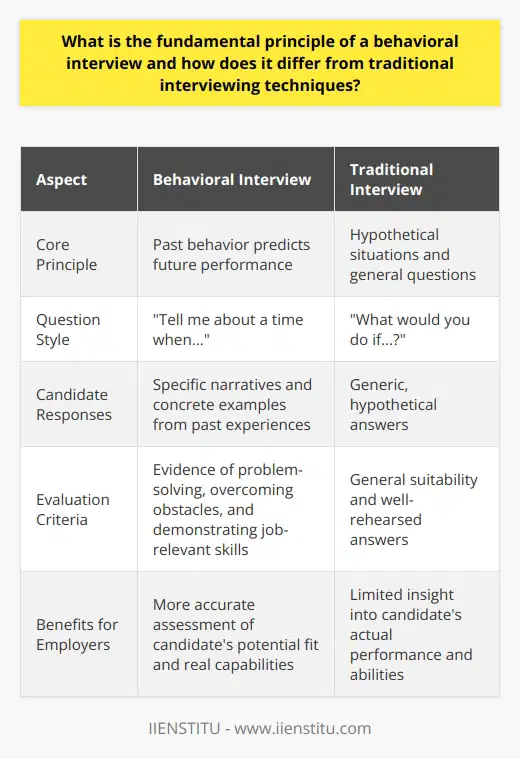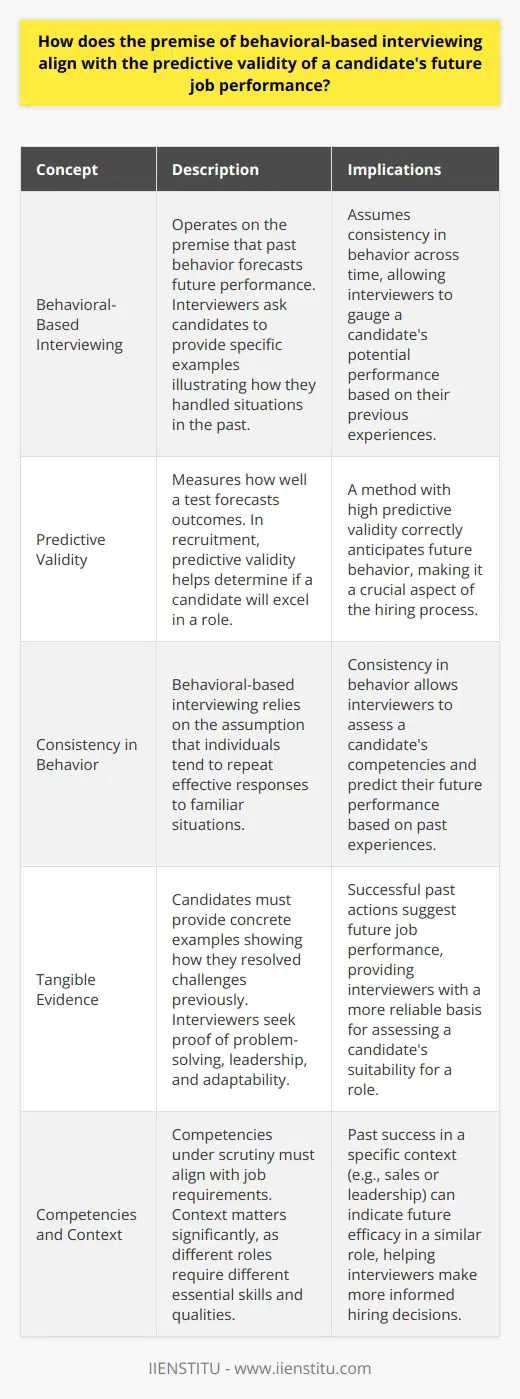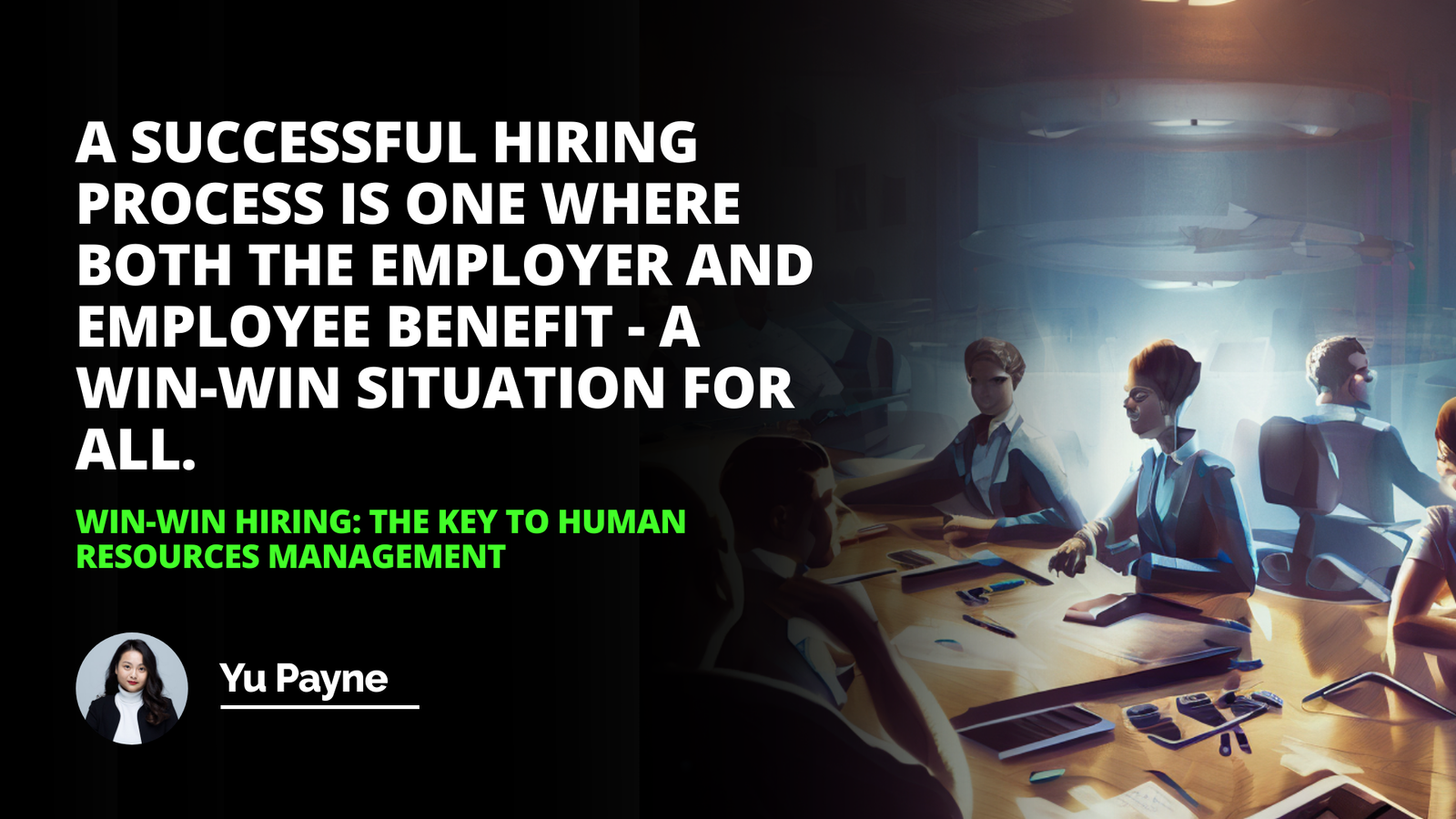
In today's fiercely competitive job market, where candidates come armed with impressive qualifications and polished resumes, employers face the daunting task of identifying not just capable individuals, but those who are uniquely suited to thrive within their organization. It's in this context that behavioral interviews have emerged as a crucial tool for evaluating potential hires beyond the traditional metrics of experience and education.
As someone who has been on both sides of the interview table, I can attest to the transformative power of behavioral interviews. I remember my first experience with this technique as a nervous job seeker fresh out of college.
The interviewer asked me to describe a time when I had to deal with a difficult team member on a group project. I was caught off guard, expecting the usual "What are your strengths and weaknesses?" Instead, I found myself recounting a real-life situation that revealed more about my problem-solving skills and interpersonal abilities than any rehearsed answer could have.
This article aims to offer a comprehensive review of the principles and practice of behavioral interviews, a technique designed to predict future job performance based on past behavior in similar scenarios.
By examining the various aspects of this interview style, we hope to equip both interviewers and interviewees with a deeper understanding and appreciation for this dynamic and revealing approach to talent acquisition.
Brief Background on Behavioral Interviews
Behavioral interviews are a methodical approach designed to unearth the experiential narratives of candidates - narratives that are telling of their future potential within a given role.
Originally developed in the 1970s by industrial psychologists, this technique has now become a staple in human resources practices. Businesses across industries have come to value the insights derived from probing into how candidates have navigated specific work-related challenges in the past.
The genesis of behavioral interviewing can be traced back to the work of Dr. Tom Janz, who proposed that the best predictor of future behavior is past behavior. This simple yet profound insight revolutionized the hiring process, shifting the focus from hypothetical scenarios to concrete past experiences.
Importance of Behavioral Interviews
Understanding past behavior is predicated on the notion that it is amongst the best predictors of future behavior. Behavioral interviews offer companies a window into a candidate's problem-solving, leadership, and interpersonal skills, which standard questioning might fail to uncover. In an era where the right talent can significantly influence an organization's direction and success, optimizing the interviewing process is not just a necessity but a strategic imperative.
Let me share a personal anecdote that illustrates this point. A few years ago, I was part of a hiring committee for a critical project manager position. We interviewed two candidates with nearly identical qualifications on paper. However, the behavioral interview revealed stark differences.
One candidate described how they had successfully navigated a project that was behind schedule and over budget, demonstrating resourcefulness and leadership. The other struggled to provide concrete examples of handling similar challenges. Needless to say, the first candidate got the job and went on to become one of our top-performing project managers.
Understanding Behavioral Interview
Definition of a Behavioral Interview
At its core, a behavioral interview concentrates on experiences, responses, and actions that candidates have taken in particular job-related situations. It relies on the premise that discussing concrete past actions rather than hypothetical responses offers a more accurate indicator of future success within similar contexts. By delving into candidates' past experiences, interviewers glean a more authentic representation of skills, behaviors, and attitudes.
Concept of Behavioral Interviews
The essence of a behavioral interview lies in its ability to zero in on specific instances that can reveal a candidate's thought processes and values. This personalized approach can create a more vivid portrait of the candidate as a potential employee, making it an integral tool for scrutinizing the fine-grain details of a candidate's professional history.
For instance, instead of asking, "How do you handle stress?", a behavioral interview question might be, "Tell me about a time when you were under significant pressure at work. How did you handle it?" This subtle shift in questioning can yield remarkably different and more insightful responses.
Role of Behavioral Interview in Assessing Potential Candidates
A well-structured behavioral interview can illuminate how a candidate has handled complex projects, navigated teamwork dilemmas, and exhibited resilience in the face of workplace adversity. These are crucial elements that can determine a candidate's aptitude for leadership and collaborative work environments.
Factors Influencing Behavioral Interview
Behavioral interviews are influenced by various factors, including the role being interviewed for, the organizational culture, and the competencies essential for job success. Adjusting the interview to account for these parameters is critical in obtaining relevant and insightful information.
For example, when interviewing for a customer service position, questions might focus on instances of dealing with difficult customers or resolving conflicts. On the other hand, for a software developer role, the questions might revolve around problem-solving abilities or experiences with meeting tight deadlines.
Benefits of Behavioral Interviews
Predicting Future Performance
The greatest advantage of a behavioral interview is its potential predictive power with regard to a candidate's future performance. By examining past behavior, interviewers can make educated guesses about how a candidate will approach and resolve future challenges, how they will mesh with a team, or adapt to the demands of the role.
I once interviewed a candidate for a sales position who described how they had turned a dissatisfied client into a loyal customer. This story not only demonstrated their problem-solving skills but also their ability to build and maintain relationships - crucial traits for success in sales.
Ensuring Job Compatibility
Behavioral interviews can also significantly increase the likelihood of job compatibility. Candidates who resonate well with the core values of the company and who have demonstrated behaviors aligned with the job requirements are more likely to excel and have higher job satisfaction.
Reducing Bias and Encouraging Diversity
Traditional interviews can sometimes unconsciously perpetuate bias. However, by focusing on a candidate's past behaviors rather than subjective assessments, behavioral interviews can level the playing field, making room for a more diverse and inclusive workforce.
Structure of a Behavioral Interview
Key Components of a Behavioral Interview
The structure of a behavioral interview is paramount in facilitating the collection of relevant data. A carefully crafted interview will include an inventory of competencies that are directly linked to job performance, ensuring the entire conversation is geared toward those pre-established criteria.
Identifying Essential Job-Related Skills
Before conducting a behavioral interview, it is essential to identify the skills and behaviors that are critical for success in the role. This often involves a thorough job analysis and understanding of the tasks that the successful candidate will be expected to perform.
Formulating Behavioral Interview Questions
Crafting questions that can elicit detailed behavioral responses is the crux of this interview style. These questions should be open-ended and require the candidate to describe specific examples of their experiences.
Some examples of effective behavioral interview questions include:
"Tell me about a time when you had to work with a difficult colleague. How did you handle the situation?"
"Describe a project that didn't go as planned. What did you do to get it back on track?"
"Can you share an example of when you had to persuade someone to see things your way? What was your approach?"
Discussing the STAR (Situation, Task, Action, Result) Method
One common framework used to guide candidates in structuring their responses is the STAR method. This technique encourages candidates to outline the Situation they were in, the Task at hand, the Actions they took, and the Result of those actions.
For example, when asked about a time they resolved a conflict, a candidate might respond:
Situation: "In my previous role, there was a disagreement between the marketing and sales teams about the messaging for a new product launch."
Task: "As the project manager, it was my responsibility to ensure both teams were aligned and the launch went smoothly."
Action: "I organized a workshop where both teams could voice their concerns and collaborate on finding a solution. I facilitated the discussion, ensuring everyone's views were heard and respected."
Result: "We were able to create a messaging strategy that satisfied both teams, and the product launch was a success, exceeding our sales targets by 20%."
Role of the Interviewer in a Behavioral Interview
The interviewer has a pivotal role in steering the behavioral interview towards conclusive outcomes by maintaining focus on the job-relevant skills and ensuring the candidate has ample opportunity to provide comprehensive responses.
Scheduling and Conducting the Interview
The interviewer must manage the flow of the conversation while ensuring that enough time is given to explore each relevant competency. This necessitates a balance between thoroughness and efficiency.
Evaluating Candidate Responses
Interviewers must be adept at dissecting responses to behavioral questions, looking for evidence of problem-solving, adaptability, teamwork, and other important skills. The ability to distinguish between genuine, substantive responses and those that are ambiguous or irrelevant is a vital part of evaluating a candidate's fit for the position.
Practical Strategies for Interviewees in a Behavioral Interview
How to Prepare for a Behavioral Interview
Candidates facing a behavioral interview should undertake a detailed preparation process to ensure they can convey their experiences convincingly and professionally.
Researching about the Company and Position
andidates should thoroughly research the company and understand the competencies required for the role. Doing so helps tailor responses to demonstrate alignment with the organization's values and needs.
Identifying Potential Behavioral Interview Questions
Potential questions can often be predicted based on the job description and required competencies. Reflecting on pertinent examples from one's professional past and preparing to discuss these in detail can set candidates apart.
Structuring Responses using the STAR Method
Utilizing the STAR method provides a framework for candidates to deliver coherent and focused narratives that underscore their qualifications and readiness for the role.
Maintain Composure During the Interview
It's crucial for candidates to stay calm and collected during a behavioral interview. Practicing responses and adopting relaxation techniques can help maintain composure, ensuring clear and concise communication.
Importance of Follow-Up After the Interview
An often-underestimated aspect of interviews, the follow-up message can demonstrate a candidate's continued interest and professionalism, solidifying a positive impression with potential employers.
Pitfalls to Avoid in a Behavioral Interview
Common Mistakes by Interviewers
Interviewers must avoid the temptation to ask leading questions or to make snap judgments based on initial impressions. They should also be wary of not devoting enough time to probe deeply into candidates' responses.
Common Mistakes by Interviewees
Interviewees, on the other hand, should steer clear of vague or generic answers. They must avoid exaggeration, instead focusing on giving concrete, truthful examples. Poorly articulating the link between past behaviors and potential future performance can also be detrimental.
Case Studies on the Success of Behavioral Interviews
Examples of Companies Successfully Using Behavioral Interviews
Several forward-thinking organizations have integrated behavioral interviews into their talent acquisition strategy. By doing so, these companies report higher employee retention rates, enhanced job performance, and a stronger alignment between employees' values and the company culture.
For instance, Google has long been known for its rigorous interview process, which includes behavioral interviews. They use these interviews to assess candidates' problem-solving skills, ability to work in ambiguous situations, and cultural fit.
Review of Specific Scenarios Where Behavioral Interviews Have Been Effective
Case studies have shown that behavioral interviews can be especially effective in roles requiring a high degree of interpersonal skills, such as customer service, sales, and healthcare positions. Sharing these specific scenarios showcases how nuanced and tailored behavioral interviews can unearth the best talent for a position.
Summary of Key Points About This Article:
Behavioral interviews, when executed well, offer a robust mechanism for predicting a candidate's job performance and ensuring a suitable match between the candidate's abilities and the role in question. By focusing on past behaviors as indicators of future success, this interview technique adds depth and dimension to the hiring process.
Concluding Thoughts on Behavioral Interview Practices
It is our hope that this examination provides valuable insights for both practitioners of behavioral interviewing and those on the receiving end. For organizations considering incorporating or enhancing their use of behavioral interviews, considering HR certificate programs that train on the nuances of this approach could be beneficial. Likewise, candidates seeking to better prepare for these interviews might find online certification courses in interview preparation pivotal to their success.
Ultimately, mastering the art of the behavioral interview can lead to more meaningful hiring decisions, fostering a workforce that is both skilled and well-matched to the organization's goals and culture. As we navigate an increasingly complex job market, the ability to conduct and participate in effective behavioral interviews will undoubtedly become an invaluable skill for both employers and job seekers alike.
References:
Janz, T. (1982). Initial comparisons of patterned behavior description interviews versus unstructured interviews. Journal of Applied Psychology, 67(5), 577-580.
Campion, M. A., Palmer, D. K., & Campion, J. E. (1997). A review of structure in the selection interview. Personnel Psychology, 50(3), 655-702.
Huffcutt, A. I., & Arthur, W. (1994). Hunter and Hunter (1984) revisited: Interview validity for entry-level jobs. Journal of Applied Psychology, 79(2), 184-190.
Barclay, J. M. (2001). Improving selection interviews with structure: organisations' use of "behavioural" interviews. Personnel Review, 30(1), 81-101.
Levashina, J., Hartwell, C. J., Morgeson, F. P., & Campion, M. A. (2014). The structured employment interview: Narrative and quantitative review of the research literature. Personnel Psychology, 67(1), 241-293.
Frequently Asked Questions
What is the fundamental principle of a behavioral interview and how does it differ from traditional interviewing techniques?
Behavioral Interviewing: Understanding the Core Principle
At the heart of a behavioral interview lies the predictive principle. This principle suggests that past behavior forecasts future performance. Employers embrace this interviewing style. They seek to uncover concrete examples of how candidates have demonstrated job-relevant skills in the past.
How Behavioral Interviews Stand Apart
Behavioral interviews differ from traditional techniques mainly in content focus. Traditional interviews often concentrate on hypothetical situations. They ask questions like "What would you do if...?"
In contrast, behavioral interviews ask "Tell me about a time when...". This shift demands specific narratives from candidates about their past experiences. As a result, candidates provide more substantial evidence of their abilities.
Structuring Behavioral Questions
Interviewers use the STAR method to structure questions. Stands for Situation. Targets the Task. Alludes to Action. Refers to Result. This method ensures that responses contain a clear chronological story. Stories show how candidates applied skills to real-world challenges.
The specificity is key in behavioral interviews. Candidates must dig deep into their experience. They must relay detailed scenarios that reveal their competencies. Traditional interviews may rely more on general questions. Behavioral interviews require introspection and self-awareness.
Evaluating Candidate Responses
In behavioral interviews, metrics of success are clear and observable. Interviewers look for evidence of how candidates solved problems or overcame obstacles. Generic answers hold little weight. Instead, interviewers value detailed, action-oriented responses.
Candidates need to show, not just tell, their suitability for the role. They draw from a pool of personal anecdotes. They then have to align these anecdotes with the competencies sought by the employer.
Benefits Over Traditional Techniques
Behavioral interviews offer a more accurate assessment. They harness past actions to predict future behaviors. They minimize the guesswork that often accompanies traditional interviewing.
Candidates find it harder to feign responses. They cannot rely on well-rehearsed, generic answers. Instead, their true experience and abilities come to the fore. For employers, this means a more transparent view of the candidate's potential fit.
In sum, the fundamental principle of a behavioral interview is its predictive nature. It assesses candidates based on what they have actually done. This approach stands in stark contrast to the speculative nature of traditional interviews. Employers gain a more reliable means of evaluating potential hires. Candidates, in turn, receive a platform to showcase their real, evidenced capabilities.

How does the premise of behavioral-based interviewing align with the predictive validity of a candidate's future job performance?
Understanding Behavioral-Based Interviewing
Behavioral-based interviewing operates on a simple premise. Past behavior forecasts future performance. Interviewers ask candidates to provide specific examples. These illustrate how they handled situations in the past. The technique assumes consistency in behavior across time.
The Principle of Predictive Validity
Predictive validity measures how well a test forecasts outcomes. A method with high predictive validity correctly anticipates future behavior. In recruitment, predictive validity is of utmost importance. It helps determine if a candidate will excel in a role.
Consistency is Key
Behavioral-based interviewing centers on prior experiences. These experiences are probed for evidence of desired competencies. Consistency in behavior is a core assumption. Individuals tend to repeat effective responses to familiar situations.
Emphasis on Tangible Evidence
Candidates must provide concrete examples. These must show how they resolved challenges previously. The more detailed the response, the better the evidence. Interviewers seek proof of problem-solving, leadership, and adaptability. Successful past actions suggest future job performance.
Competencies and Context
Competencies under scrutiny must align with job requirements. Context matters significantly. A sales role differs from a managerial position in essentials. Past sales success can indicate future sales efficacy. Leadership in another context may predict managerial success.
Limitations and Considerations
Behavioral-based interviewing is not infallible. It rests on the assumption of unchanging environments. Yet, workplaces evolve. New challenges emerge. Candidates must adapt to shifting contexts.
Structured Interviews Enhance Reliability
Structured interviews follow a set pattern. Each candidate faces identical questions. This standardization helps minimize bias.
Follow-up Questions Clarify Scenarios
Probing further can elicit more nuanced information. Follow-up questions can uncover deeper insights. They help interviewers understand the thought process.
Validation Requires Holistic Evaluation
No single method guarantees perfect predictive validity. Interviews form just one part of a comprehensive assessment process. References, work samples, and tests complement interviews. Cross-checking evidence strengthens validity.
In conclusion, behavioral-based interviewing aligns well with predictive validity. It uses past behavior as a gauge for future job performance. However, it must integrate within a broader evaluative framework. This increases reliability and better assures a candidate's suitability for a role.

Could you elucidate the common practices involved in conducting a successful behavioral interview?
Behavioral Interview Fundamentals
Behavioral interviews evaluate potential job performance. They dig into past behaviors. These behaviors predict future actions. This approach is common in modern hiring practices.
Preparation is Key
Job analysis informs interview design. It outlines necessary competencies. It identifies critical behaviors for success. Interviewers must understand these competencies well.
Customarily, interviewers prepare standardized questions. These questions probe specific situations. They focus on experiences, actions, and results. It is essential never to improvise during the interview. Consistency ensures fairness.
Preparations also involve evaluation rubrics. These guide the rating process. They help maintain objectivity. Interviewers must know these rubrics thoroughly before the interview.
Conducting the Interview
Interviewers often start with a warm-up. This eases candidate anxiety. It builds rapport. They then transition to the core behavioral questions.
Behavioral questions typically start with prompts. These prompts include "Tell me about a time when..." or "Give me an example of...". Each question probes a different competency.
Probing questions may follow initial responses. They seek deeper insights. They clarify the context, actions, and outcomes.
Active listening is crucial. Interviewers must pay close attention. It ensures they grasp the full scope of answers.
Post-Interview Evaluation
After interviews conclude, the evaluation begins. It often occurs through structured discussions. Notes taken during the interview inform this process. They must be comprehensive.
Interviewers compare candidate responses against rubrics. They look for evidence of competencies. They focus on behaviors, not feelings or thoughts. This ensures a fair assessment.
Finally, deliberation reaches consensus on candidate fitness. Interviewers rely on observed behaviors for these decisions.
Feedback and Analysis
Offering interview feedback is significant. It supports continuous improvement. Candidates benefit. Interviewers learn too.
Consistency in feedback delivery is paramount. It also needs to be constructive. It should focus on behaviors, not personal attributes.
Continual refinement of the interview process is a must. It includes updating questions and rubrics. It involves training interviewers. It ensures the process remains effective.
Behavioral interviews demand diligence, structure, and reflection. Systematic practices ensure comprehensive evaluations. They lead to successful hires. Continuous improvement sharpens their effectiveness over time.



